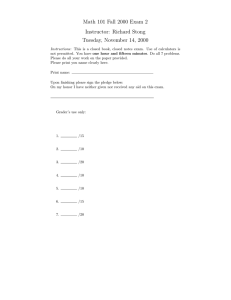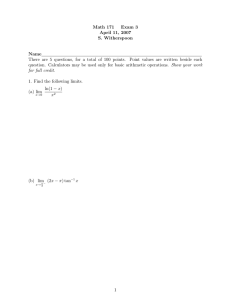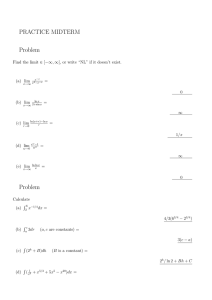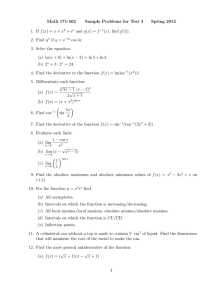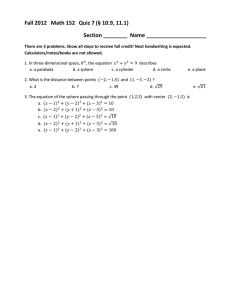PRACTICE MIDTERM Problem
advertisement
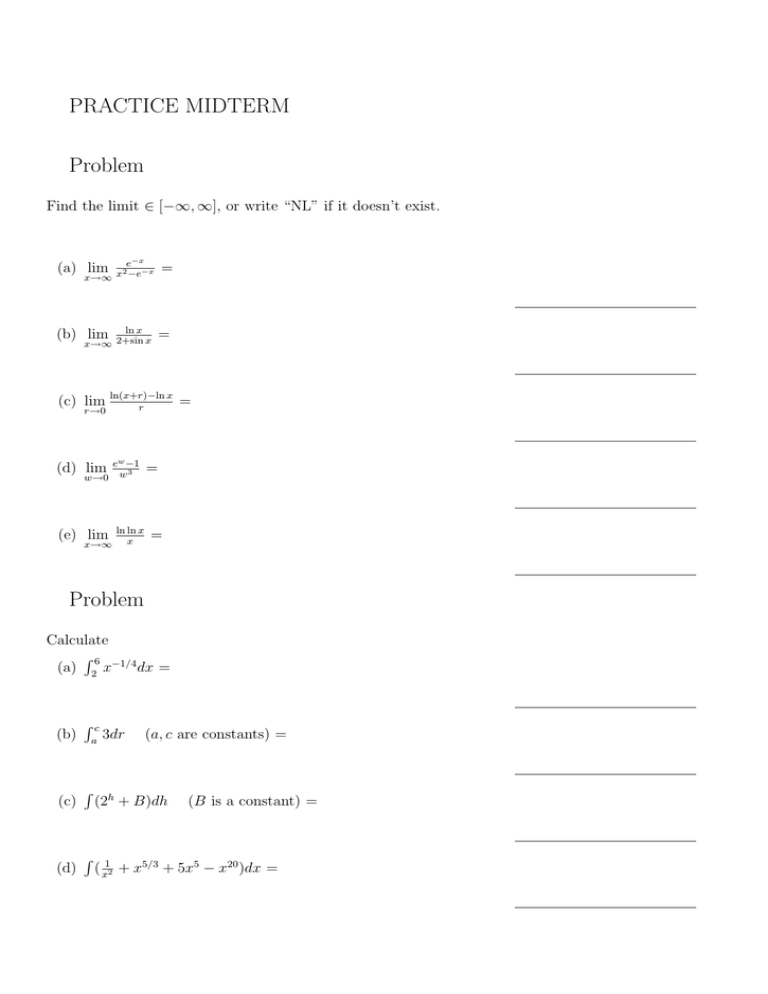
PRACTICE MIDTERM Problem Find the limit ∈ [−∞, ∞], or write “NL” if it doesn’t exist. e−x 2 −e−x x x→∞ (a) lim ln x x→∞ 2+sin x (b) lim = = x = (c) lim ln(x+r)−ln r r→0 (d) lim w→0 (e) lim x→∞ ew −1 w3 ln ln x x = = Problem Calculate R6 (a) 2 x−1/4 dx = (b) Rc (c) R (2h + B)dh (d) R ( x12 + x5/3 + 5x5 − x20 )dx = a 3dr (a, c are constants) = (B is a constant) = √ tan( 5s2 − s)ds, (a is a constant) = (e) d dx Rx (f) d dx R x2 (g) d dx (h) 2 d (2t ) dt a x √ cos( t)dt = sin−1 (2x + 3y) (y is a constant) = = (i) Write as a single integral: R2 8 f (s)ds − R 10 8 f (s)ds = Problem (a) If g(−1) = 2, g 0 (−1) = 8, find d −1 g (x)|x=2 . dx (b) Given f (x) = x3 + x + 1, find d (f −1 (x))|x=1 . dx Problem (a) Write R9 7 e3x dx as a limit of Riemann sums. (b) Write the following limit as a definite integral: n X i i (5 + )2 lim n→∞ 4n 4n i=1 Problem Suppose you are trying to use Newton’s method to find a positive value of x that solves f (x) = 0, where f (x) = e−x + sin x. (a) Write down an expression for the next best guess x2 , if you start with an initial guess of x1 = 1. (Don’t evaluate it.) (b) Describe one thing that could go wrong with Newton’s method. Problem The rate of growth of a population is given by dP dt = 0.5P (t). (a) If the population at time t = 0 is 1000, what is P (t)? (b) What is the average of P (t) on t ∈ [2, 10]? (c) What is the area under P (t) from t = 2 to t = 10? Problem 6 Consider the function f (x) = sin x − x on the interval −5 ≤ x ≤ 5. (a) Find the critical points in (−5, 5) (you don’t have to consider the endpoints). (b) Are there any local maxima or minima on the interval (−5, 5), and if so, what are they? (c) What is the absolute maximum of f (x) on [−5, 5]? (d) What is the absolute minimum of f (x) on [−5, 5]? (e) Find all the inflection points of f (x) on (−5, 5). (f) On what interval(s) is f (x) concave up? (g) Sketch a graph of f (x). It doesn’t have to be completely precise, but make sure you have the right local maxima/minima and that it is concave up / concave down in the right places. Problem 6 (a) State the Mean Value Theorem for derivatives. (b) Suppose a plane flies 300km in 3 hrs. What does the Mean Value Theorem tell you about the slope of at least one of the tangent lines of its velocity, v(t), on t ∈ (0, 3)?

